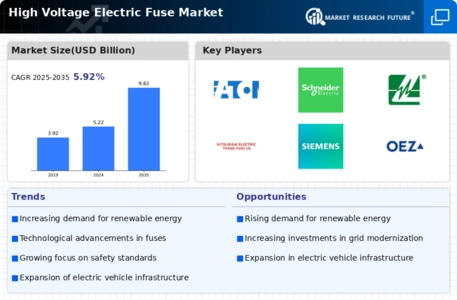Growth in Industrial Applications
The growth of industrial applications is significantly impacting the High Voltage Electric Fuse Market. Industries such as manufacturing, mining, and energy are increasingly relying on high voltage systems, which require robust protection against electrical faults. High voltage electric fuses are essential in these applications, providing reliable protection and ensuring operational continuity. Recent market analysis suggests that the industrial sector is projected to expand at a rate of around 5% annually, driven by technological advancements and increased production capacities. This growth in industrial applications not only boosts the demand for high voltage electric fuses but also emphasizes the need for enhanced safety measures in high voltage environments.
Increased Focus on Safety Regulations
The heightened focus on safety regulations and standards is a crucial driver for the High Voltage Electric Fuse Market. Governments and regulatory bodies are implementing stringent safety measures to protect electrical systems and ensure public safety. Compliance with these regulations necessitates the use of high-quality protective devices, including high voltage electric fuses. Recent data indicates that the global market for electrical safety equipment is expected to grow at a rate of approximately 6% per year, reflecting the increasing importance of safety in electrical installations. This trend underscores the necessity for high voltage electric fuses, as they are integral to meeting safety standards and preventing electrical hazards.
Technological Innovations in Fuse Design
Technological advancements in fuse design and materials are reshaping the High Voltage Electric Fuse Market. Innovations such as the development of smart fuses, which can monitor and communicate operational data, are gaining traction. These advanced fuses offer enhanced performance and reliability, catering to the evolving needs of modern electrical systems. The market for smart fuses is anticipated to grow significantly, with projections indicating a potential increase of over 15% annually. This growth is attributed to the rising demand for intelligent electrical systems that require sophisticated protective devices. As technology continues to evolve, the integration of advanced features in high voltage electric fuses is likely to become a key driver of market growth.
Expansion of Electrical Grid Infrastructure
The ongoing expansion and modernization of electrical grid infrastructure significantly influence the High Voltage Electric Fuse Market. As urbanization accelerates, the demand for reliable and efficient power distribution systems increases. High voltage electric fuses are essential components in these systems, providing necessary protection against electrical faults. Recent statistics suggest that investments in grid infrastructure are expected to reach trillions of dollars over the next decade, driven by the need for enhanced reliability and efficiency. This expansion not only supports the integration of renewable energy sources but also necessitates the installation of advanced protective devices, including high voltage electric fuses, to ensure the safety and reliability of the electrical grid.
Rising Demand for Renewable Energy Solutions
The increasing emphasis on renewable energy sources, such as solar and wind, is driving the High Voltage Electric Fuse Market. As more countries invest in sustainable energy infrastructure, the need for reliable protection devices becomes paramount. High voltage electric fuses play a critical role in safeguarding electrical systems from overloads and faults, ensuring the stability of renewable energy installations. According to recent data, the renewable energy sector is projected to grow at a compound annual growth rate of over 8% in the coming years, further propelling the demand for high voltage electric fuses. This trend indicates a shift towards cleaner energy solutions, which necessitates robust protective measures, thereby enhancing the market for high voltage electric fuses.


















Leave a Comment